
Sokol was founded by Miroslav Tyrs and Jindrich Fügner in 1862 as the first physical education organization in the Austro – Hungarian empire at a time of political freedom in the 1860´s.
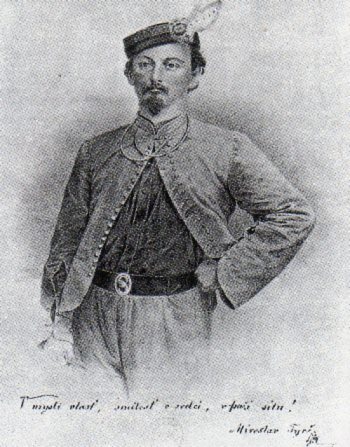
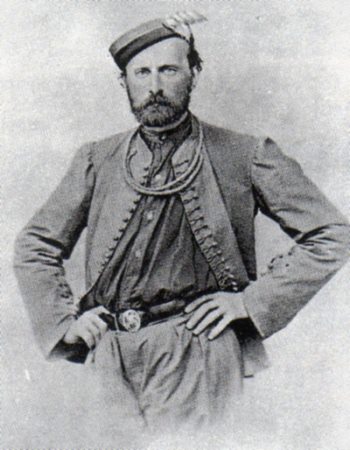
Miroslav Tyrs and Jindrich Fügner - the Founders of Sokol
Many significant Czech patriots took part in the foundation of The Prague Gymnastic Association (renamed Prague Sokol). The foundation of the unit in Prague took place on February 16th, 1862. Eight other units were founded in Bohemia and Moravia in the same year.
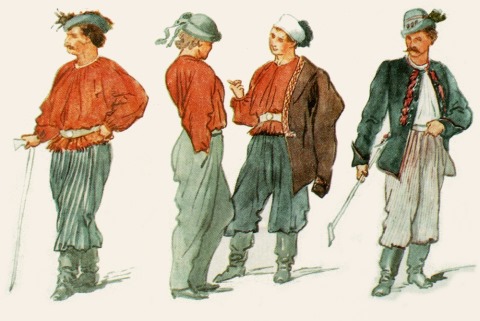
Designs for the Sokol kroj by Josef Manes 1862
The first flag of Sokol was painted on silk by the famous Czech painter Josef Manes.

The original Sokol flag
It was unflured on June 1st, 1862 at a grand ceremony in the presence of various dignitaries of the Czech state and Karolina Svetla became the mother of the flag.

The Grand Sokol flag ceremony 1862
The leader M. Tyrs invented gymnastic exercises and terminology (The Basis of Gymnastics).
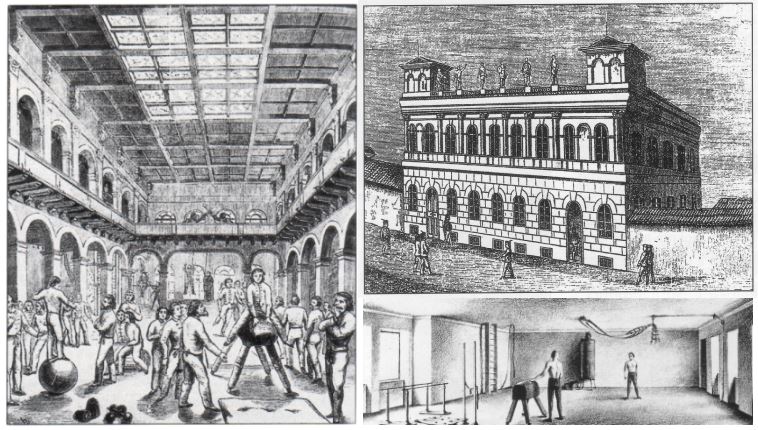
Sokolovna - The gym for the Sokols (designed by Vojtech Ignaz Ullmann 1863 )
In 1869, the Gymnastic Society of Czech Women and Girls was founded, and Klemena Hanusova, a proponent of female physical education and Tyrs´s pupil, became the leader of the society.
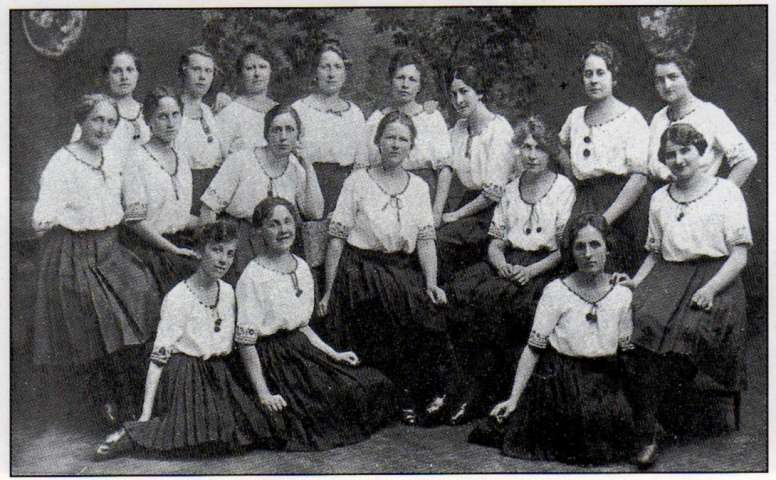
Sokolice - Sokol women -Slet VII 1920
The patriotism of Sokol was to be seen from the very beginning - Sokols made trips in national costumes (Kroj), were present to national ceremonies, public exercises, etc, and that all encouraged people to show their patriotism.
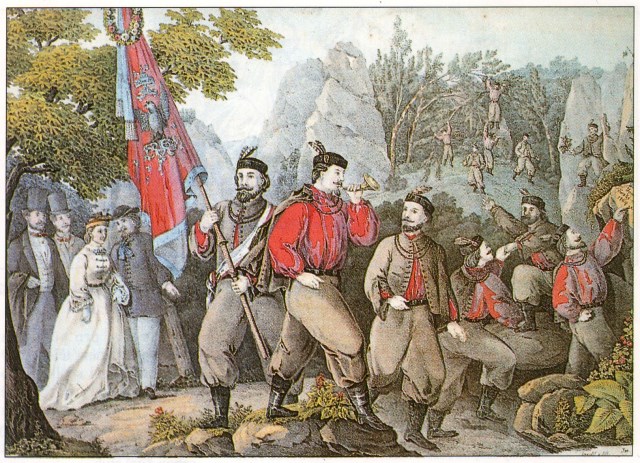
Vylet Sokolu do Divoke Sarky - colour litography from 1864
. Sokol fulfilled its patriotic role during the World War I. Whe Czechoslovak legions were founded and during the days of the revolution in October 1918, Sokol members helped to keep peace in towns. Sokols were often called Czech national army. Sokol leaders Schneider and Vanicek were one of those who started to organize a new Czechoslovak army.
***
Sokol flourished between the two World Wars. During this time, membership grew to over a million. Important statesmen including the first two presidents of the Czechoslovak republic, T.G. Masaryk and E. Benes, were members of Sokol.
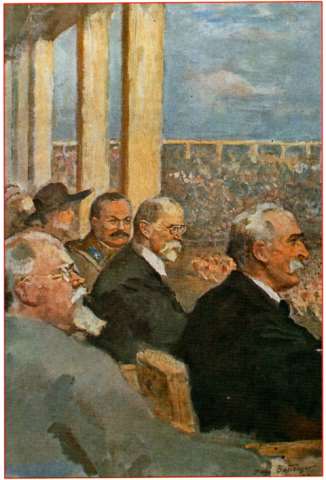
T.G.Masaryk -VII Slet 1920 (author Hugo Boettinger )
Sokol gymnasiums were built in even small communities through co-operative effort and became sport and cultural centers. Sokol members successfully represented their country at the Olympics and world championships (Supcik, Vacha, Hudec, Gajdos, Dekanova and others). The program of Sokol has always been versatile, attractive for people of all ages.
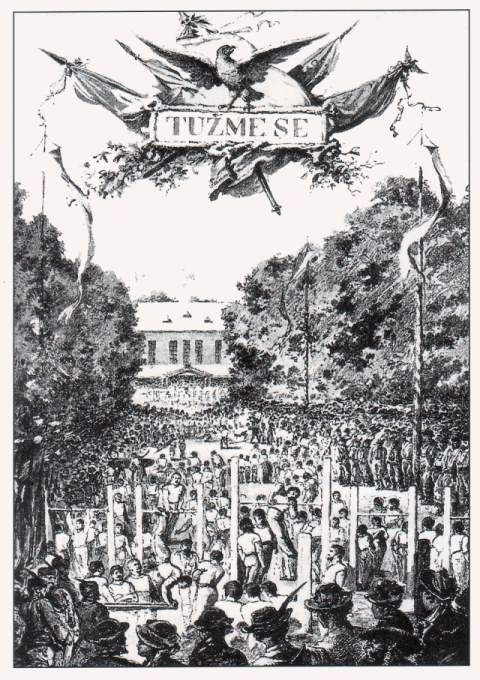
Tuzme se - the slogan of Sokol
Besides regular training of all age groups, units organized sporting competitions, cultural events including drama, literature and music, excursions and youth camps.
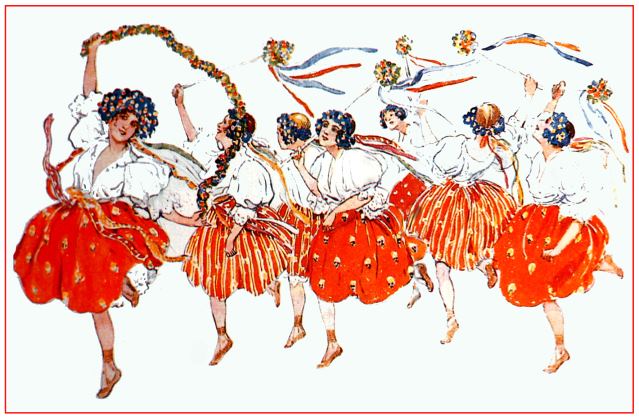
The motto for VII Slet - Construction of the Statue of Liberty (design by Adolf Wenig )
Sokol educators espoused the ideals of the movement to its members and were active in organizing discussions and exhibitions. The CSO published a wide range of magazines and booklets to assist the work of its units, including advice on organizing events and music for cultural performances and festivals. The peak of the Sokol activities were Sokol festivals- SLET .
***
Sokol was almost liquidated three times. It was banned by all totalitarian regimes in Czechoslovak history. Firstly, Sokol was banned during the World War I., in 1915.
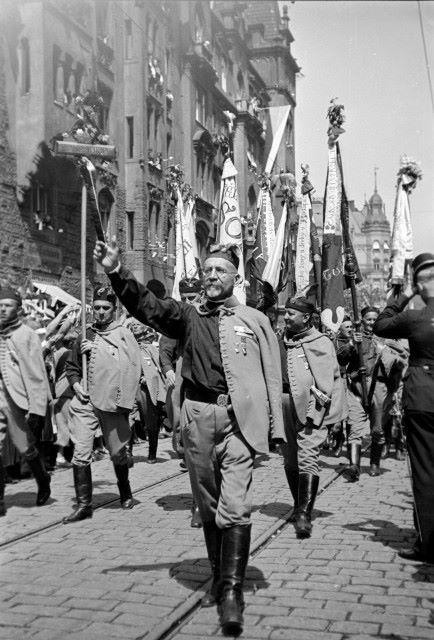
X. Sokol Slet - The last Slet before the world war II.
Secondly, it happened during the Nazi occupation of Czech lands.

Europa 1938
Finally, Sokol was banned by the communists after 1948. In 1968, struggles for Sokol revival were killed by normalization and so after 42 years of hibernation, Sokol was restored for the fourth time in 1990.
***
The beginnings of new era of Sokol are not easy.
Sokol must fight for the recovery of its gymnasiums, sportsgrounds and other property.
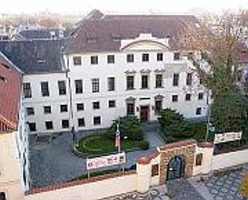 " Tyrs house "
" Tyrs house "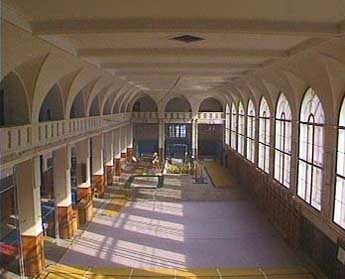
Also, Sokol faces generation problems. Today, the CSO unites almost 1100 units and 190 000 members. Almost half of the members attend sporting classes, which means that there are also many young people. More and more young people also become Sokol functionaries.
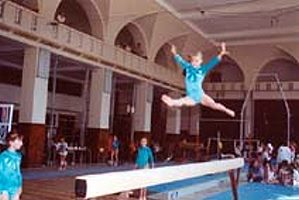
New forms of presentation. Today, Sokol offers a wide range of modern activities. It organizes untraditional events called "Us today"- for example gymnastic exhibitions, Euroteam competitions, the Terry Fox Run, etc. The Czech Sokol Organization co-operates with organizations whose program includes "Sport for all", at both national and international level (TAFISA, etc.). Sokol sportsmen also represent the Czech Republic on world-wide gymnastic exhibitions.
***
Even though the beginnings of the tradition of Sokol festivals were in 1882, the tradition survived until today. The Sokol festivals –SLET are unique phenomenon and they were always considered by all the citizens to be a very special event. They became an extraordinary show of Sokol activities, often also a great encouragement to Czechoslovak nation during threatening times in its history.
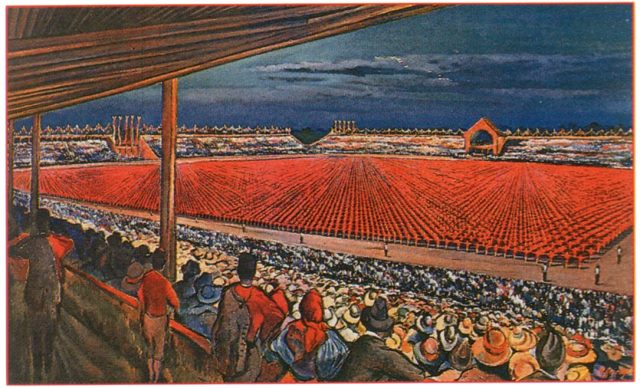
VII. Sokol Slet - Prague, Letna plain 1920 (author Otakar Nejedly)
Beside collective performances, they included also sporting competitions, shows and many other great experiences in festive Prague. Our important politicians and presidents were always present at the festivals.
The extent of the Slet grew until 1948.
I. Slet 1882 took place on June 18th, on the Strelecký Island in Prague. 700 men exercised under the leadership of Miroslav Tyrs. 1572 Sokols dressed in traditional costumes - kroj formed the procession. They held 57 flags and patriotic citizens of Prague cheered.
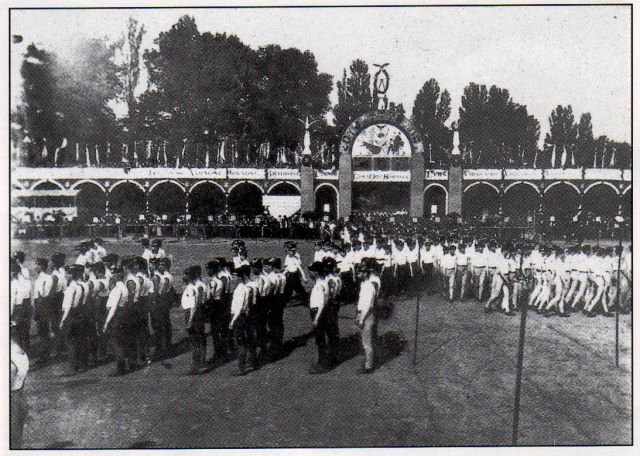
II. Sokol Slet Prague 1891
II. Slet 1891. took place in "Kralovska obora" during the Anniversary Exhibition. More than 2 400 participants showed their exercises and various competitions in front of 7 000 people. A procession containing 5 000 members including friendly foreigners marched through Prague.
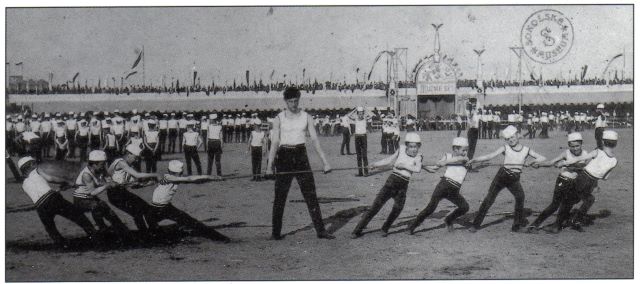
III. Sokol Slet Prague 1895
III. Slet 1895 took place during the Ethnographic Exhibition of Czechoslovakia and it was the first time it took place on the Letna plain. 5 000 participants including adolescents and foreign guests took part in competitions and the procession. More than 30 000 people came to watch the show already.
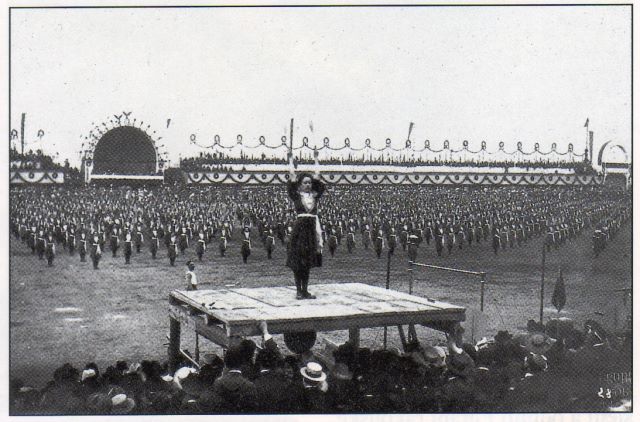
IV. Sokol Slet Prague 1901 - Women
IV. Slet 1901 included besides exercises of men and adolescents also exercises of 876 women with clubs. People from Vienna, France, Poland and Slovenia competed here, too. The poster by Mikolas Ales invited people to the festival exposition; the procession of 11 000 Sokol members climaxed by the homage to the city of Prague on the Oldtown Square.
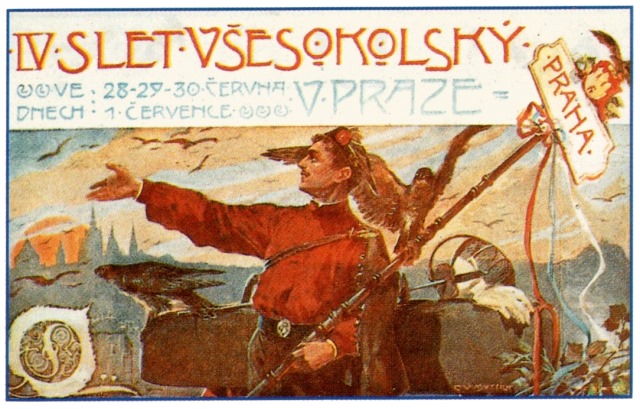
Postcard for IV. Slet
V. Slet 1907 was first "great" festival and lasted four weeks. This time, youth and women in traditional Moravian kroje also performed. 194 groups from the Czech Republic and other countries competed in various competitions. The festival scene "Chess match", picturing the victory of the Hussites over Zikmund, was brought out here for the first time. Fireworks on the Vltava river were arranged. More than 12 thousand members took part in the procession.
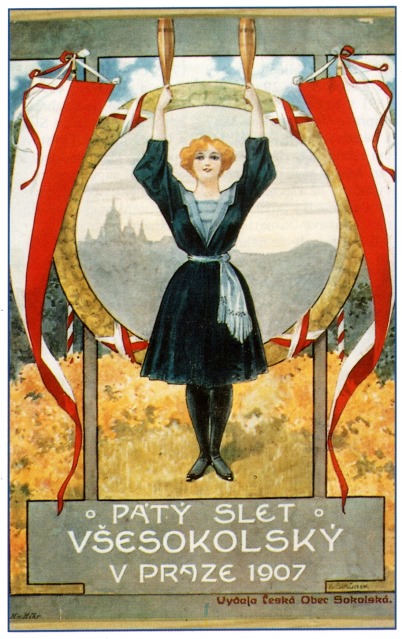
Postcard for V. Slet
VI. Slet 1912 was a social event of the Federation "Slavonic Sokol" and lasted five weeks. More than 30 000 Sokols participated and competed and ten times more people came to see it. Sokols from the USA, France and Slavic countries performed there as well. The scene "Marathon" with 1500 participants was dedicated to the ancient Greek culture. It was a great encouragement to our nation.
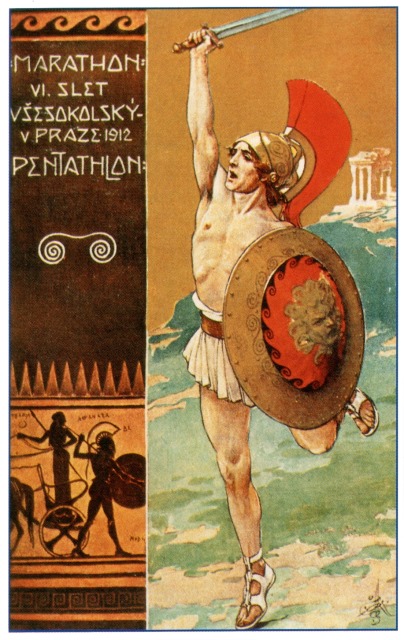
Postcard for VI. Slet
VII. Slet 1920 was the last one that took place in Letna. More than 100 000 members participated and more than 500 000 people, including the president Masaryk, came to see it. High School games took place for the first time and the new Czechoslovak army performed here as well. The foundation of the Czechoslovak Republic was celebrated by the scene "Construction of the Statue of Liberty". 78 000 Sokol members formed the procession that walked through Prague. The march "Into The New Life" from Josef Suk was to be heard here for the first time.
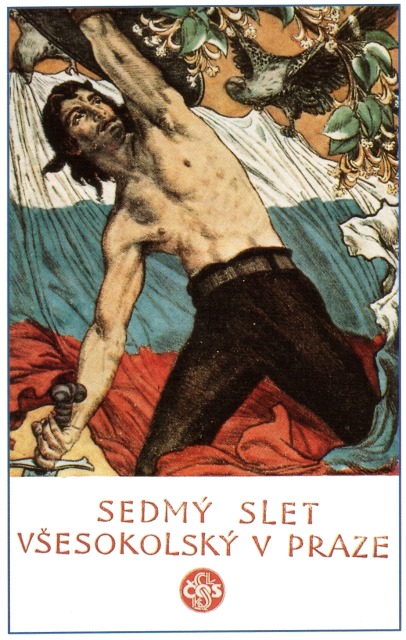
Postcard for VII. Slet ( author Jakub Obrovsky )
VIII. Slet 1926 took place on Strahov. 140 000 participants arrived and about 800 000 people came to watch them. 200 groups from the CSO and the Federation of Slavic Sokol competed here. Sokol museum was opened in the new seat of the CSO at the Tyrs House and the statue of Tyrs was unveiled. T. G. Masaryk gave a flag to Sokols. Prominent Czechoslovak artists performed in the scene "Where Is My Home".
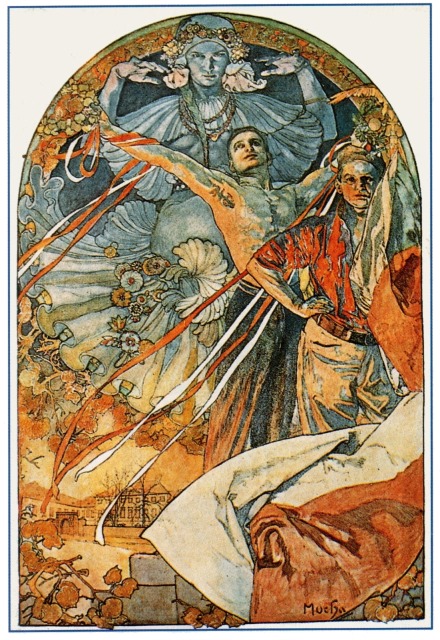
Postcard for VIII. Slet ( author Alfons Mucha )
IX. Slet 1932 became a celebration of the 100th anniversary of the birth of M. Tyrs. The festival scene was called "Tyrs' s Dream" The festival included for example a run from nine parts of the country, winter festival games, high school games, general competition of the Slavonic Sokols, many cultural programs, sporting and cultural competitions. 190 000 members participated and more than one million people watched. Three processions with 100 000 participants took place. Max Svabinsky made the poster for this festival.
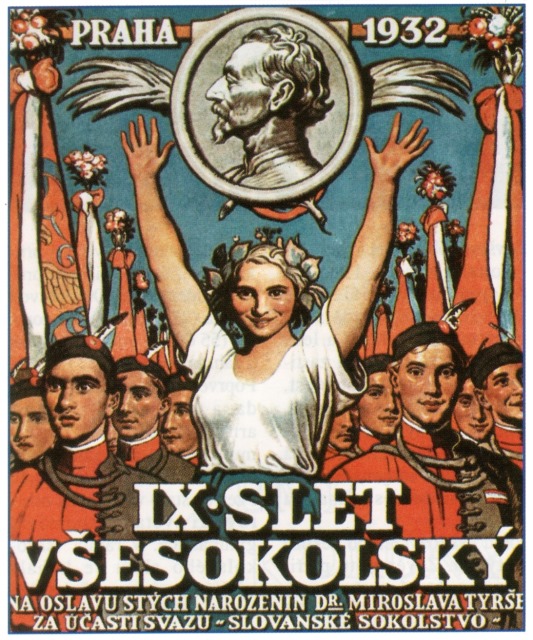
Postcard for IX. Slet (author Max Svabinsky )
X. Slet 1938 . - adolescents took place during the time of the fascist threats. 30 000 men at the same time performed the famous exercises "Oath to the Republic", the same number of women did for the first time the "great choreography". All the processions turned into demonstrations. President Benes gave a flag to the Sokol organization (to which he later pinned the War cross). About 350 000 Sokols exercised, more than two million people came to watch them. The festival became a great encouragement to the nation before the Nazi occupation.
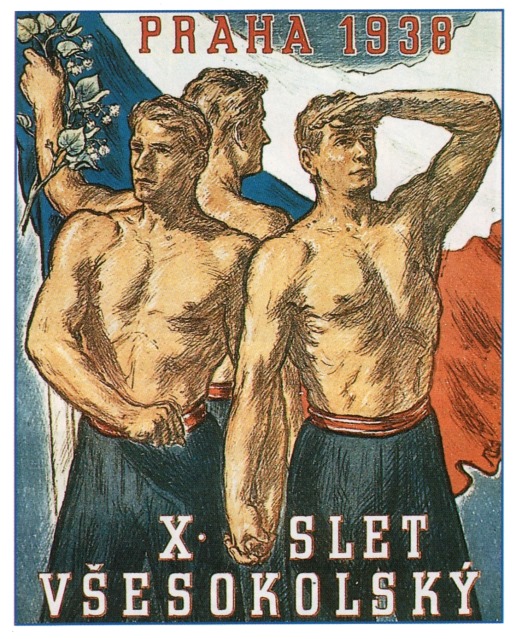
Postcard for X .Slet ( author Karel Minar )
XI. Slet 1948, - the exercises for women being prepared right after the war, finally took place after the communist putsch in February. The scene "Faithful Forever", performed by men, commemorated the Sokols that died during the war. A modern scene with clubs for women was so successful that it had to be repeated. A performance of 2500 scouts was also extraordinary. The number of participants of the festival exceeded 500 000. During the processions, demonstrations against the communist regime and president Gottwald took place. Communists socially punished more than 11 000 Sokol members after the festival.
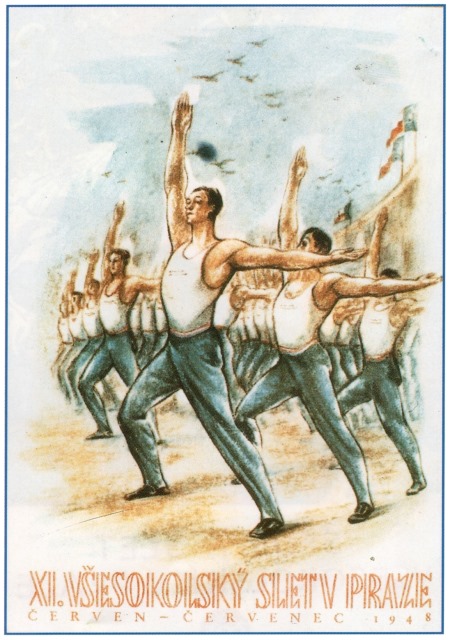
Postcard for XI. Slet
XII. Slet 1994 took - the arrival of the place after a break of 46 years. 23 000 people performed on Strahov, out of which 1800 were from abroad. Sporting competitions, cultural and social events took place. Very touching was the meeting of foreign Sokols at the performance "Sold Bride" in the National Theatre. The president Vaclav Havel came as well. During the opening, Prague bells rang and Suk' s march "Into The New Life" was played. The choreography was rearranged for less people. This festival proved that Sokol was alive again.
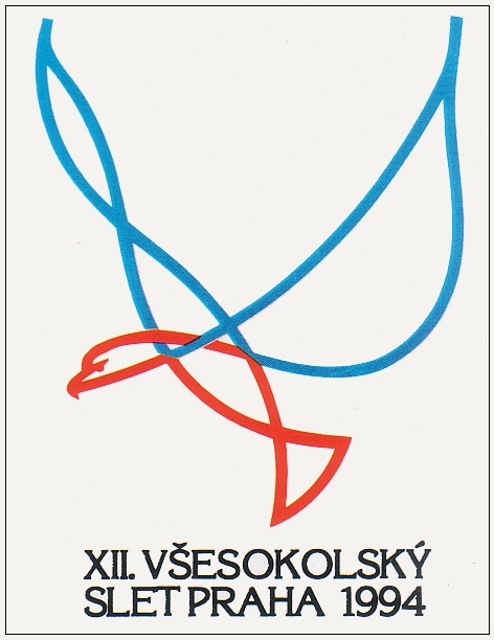
***
What is SOKOL
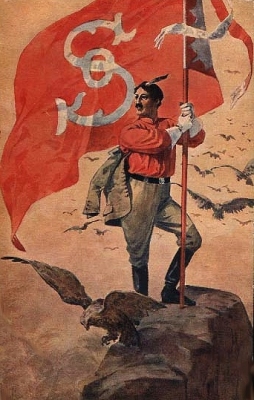
Czech Sokol Organization (CSO) is the fourth most numerous civic association in the Czech Republic, whose 180 000 members participate in sports, sporting activities in Divisions of Sokol Versatility and cultural activities, mostly in folk and marionette groups.
CSO is one of the oldest organizations of this type in the world. The philosophy of CSO is associated with the emancipation struggle of the Czech nation in the 19th Century. The idea of physical education as well as the promotion of moral values was formulated by Miroslav Tyrs, a professor of the Charles University, and by Jindrich Fugner..

Sokol Slet 1932
The philosophy, evolved from the ancient Greek ideals of "kalokagathia" and now propagated by Miroslav Tyrs and his followers, became the basis of the movement, which is connected with the origin and destiny of the Czech (Czechoslovak) Republic. For four times in its history, Sokol was banned or its activities were restricted by wars or totalitarian regimes. It was still alive, though- in other countries, in communities of Czech immigrants on all continents of the world.
In 1989, when the communist regimes in eastern Europe collapsed, the CSO was restored after a break of 42 years. The program traditions, connected with the physical education of a man responsible for himself, for his community and for democracy in his country, was renewed.
While entering a new century, the CSO modernizes its program. It supports 57 kinds of sports, which are being organized in the CSO. At gymnastics, handball, basketball, judo and athletics Sokol sportsmen reached the highest levels of both national and international competitions. The CSO also supports new kinds of sports, for example acrobatic rock´n´roll, at which the members of Sokol won the World Championship.
The most numerous part of the CSO is the Division of Sokol Versatility, in which the program of sporting activities is made. This program includes wide range of sporting activities for people of all ages and abilities, including for those who are handicapped. Sokol districts and units significantly influenced the Terry Fox Run in the Czech Republic, where, like in Canada, many people participated.
The most important event, that shows the abilities of the CSO members, is "Slet", a sport-cultural festival of all activities that the CSO practiced during last six years. CSO is organized in 43 districts covering the whole Czech Republic. Its headquarters are at the Tyrs House in Prague. Czech Sokol Organization is the most numerous organization of the World Sokol Federation.
***
Sokol philosophy
Someone wrote, that Sokol is a special world with its own soul. One who used to attend Sokol, has many memories and a very special relationship to Sokol. Sokol was a part of peoples´ lives. These people were attracted, addressed and educated by the Sokol philosophy.
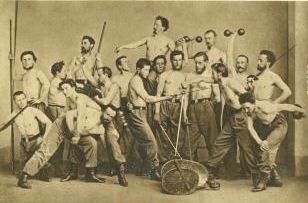
Sokols -Tyrs and his friends 1864
Miroslav Tyrs adopted the ancient saying "A healthy mind in a sound body", as well as the ancient Greek ideals of "kalokagathia" meaning the harmony of physical and mental values. Thanks to him, the effort to educate people both physically and mentally became the main aim of the Sokol activities.
Being a Sokol meant not just being in shape, but also keep the rules of equality, brotherhood, discipline, diligence, patriotism, willpower, fair play, morality, honesty, sobriety ...
Voluntary discipline was one of the main attributes of the members of Sokol and it led to the establishment of great relationships among the association. It was not easy to join Sokol. To become a member, everyone had to go through a very strict testing period. Brotherhood and mutual understanding remained among Sokols from all over the world until today.
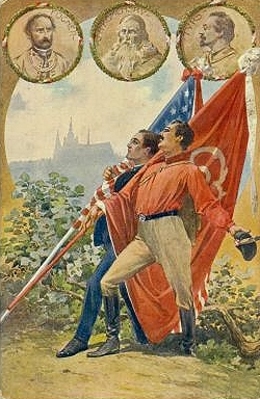
Sokols over the world
Equality, freedom, brotherhood- this motto of the French revolution adopted by Sokol, showed Sokol´s relationship to democracy. Shortly after the foundation of the association, Jindrich Fugner proposed that the members should call each other "brother". In June 1862, on the basis of Josef Barak´s proposal, it was agreed that the greeting would be "Nazdar" in stead of former "Zdar buh".
Sokols didn´t forget the ideas and philosophies of important people from the Czech history. They talk about "the morality of Hus, gallantry of Chelcicky, humanity of Komensky, patriotism of Havlicek"
Tyrs´s mottos are democratic and modern:
One changes nothing, all change everything!
Neither profit, nor glory!
The world moves, where the power is stressed!
Rush forever! Dissatisfaction forever!
Just go for it!
What people do not know, nobody knows, what people do not make, nobody made, what never happened to people, never became anything!
Forward, no step back!
Forward! Standing still means death!
Rush is our life!
The Czech Sokol Organization
modern establishment with tradition
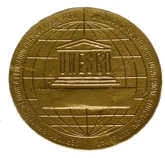
The Czech Sokol Organization awarded by UNESCO and the International
Committee for fair play prize of Pierra de Coubertina in 2004.
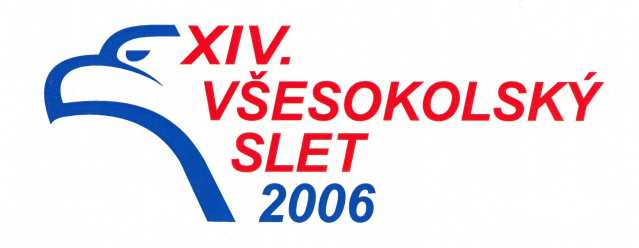
Original text and more informations about CZECH SOKOL
you can find on the oficial Czech Sokol webpage: www.sokol-cos.cz
***
webdesign copyright(c) by CZECHANTIQUEART 2006